| Author |
 Share Topic Share Topic  Topic Search Topic Search  Topic Options Topic Options
|
Podsible Dream 
podders Helping podders - pHp


Joined: 03 Dec 2010
Location: Hightstown, NJ
Online Status: Offline
Posts: 571
|
 Topic: Solar Charging System Topic: Solar Charging System
Posted: 20 Aug 2012 at 8:40pm |
I posted part of this on the end of another topic, but now have photos so I set up a new topic thread.
I just finished putting in a permanent exterior receptacle for my new solar charging system. A 30 watt panel from Instapark via Amazon, and a Morningstar Sunguard 4.5 amp controller also thru Amazon. Used a 4" outdoor box and mounted it on the back of the panel using 3/4"x1/2" alum angle and put a single receptacle in the box. The contoller is mounted to the box side as well. Simple connections - + and - for the panel, + and - for the output to the battery. Made a tripod for the panel using 1x2 PT SYP and a piece of plywood. The box is held on by a 10-24 screw through the plywood into a hole in the box - it basically hangs, and then is clamped to the leg.
Then I mounted a 20 amp receptacle from etrailer.com right next to the 30 amp inlet on the street side, labeled in big letters "Solar charger input only". Used a 14ga red extension cord and replaced the standard end with a 125v20amp receptacle to mate with the exterior outlet. (One blade is vertical, one is horizontal).
Got all the wiring tested, tested the panel before the outlet install, and then it started to rain.
Today is partly cloudy, but it has been connected up to a battery set (2 x 6V) for 7 hours and has brought them up to over 12 volts from a fairly low starting point. Looks like the system will work.
Panel mounted on tripod - front and back view
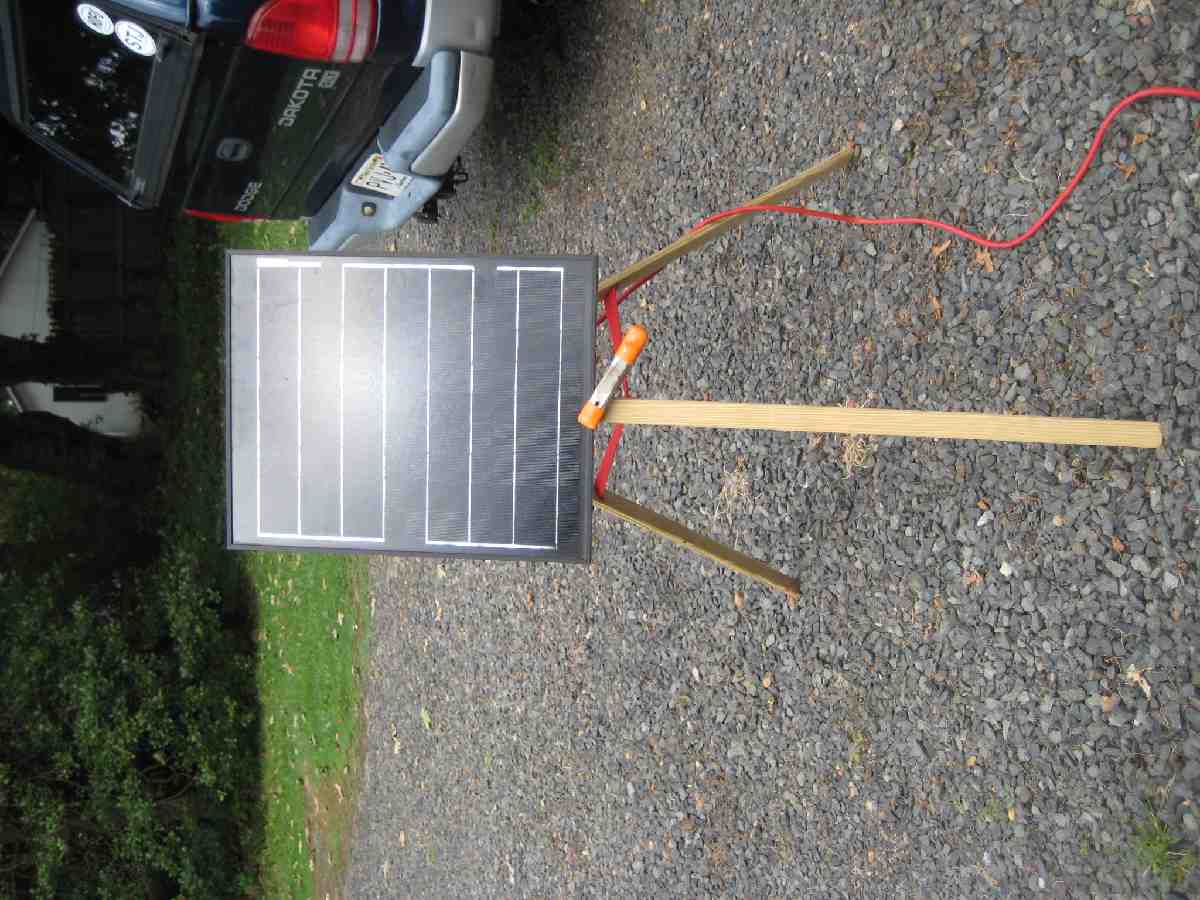
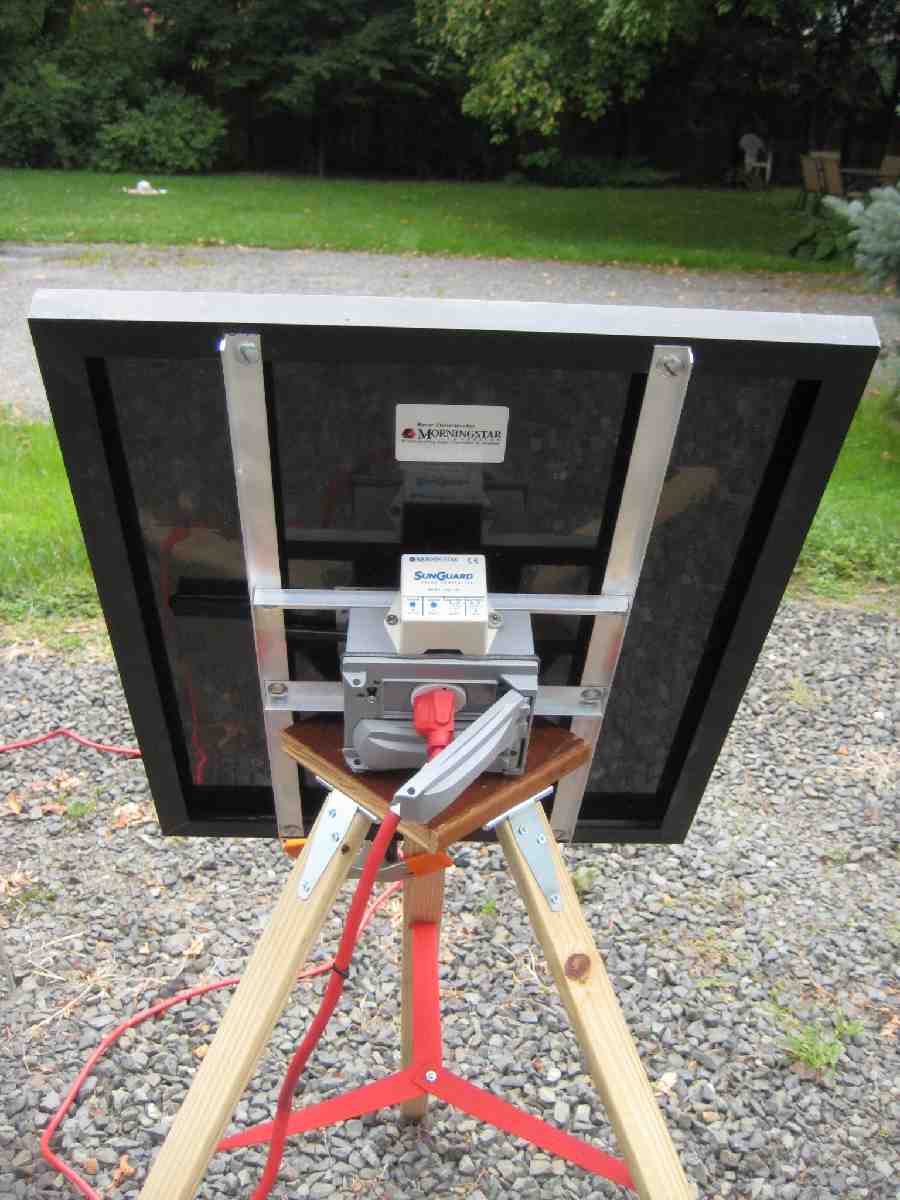
Trailer side input -
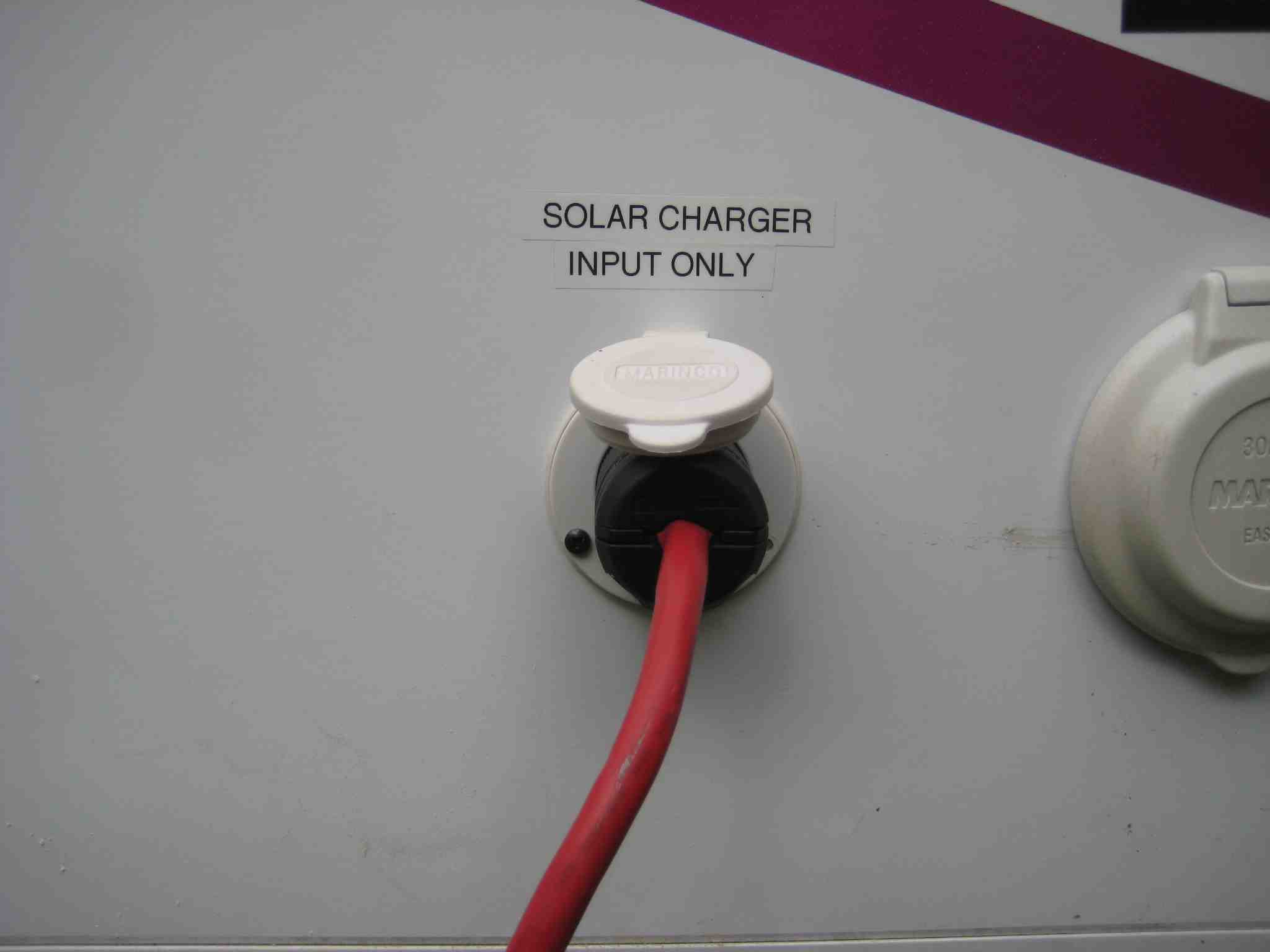
Interior of electrical chamber - 20A socket has black soft vinyl boot - internal wires are #10 solid and connect to the 12V ground bus (white) and the red to the other connection of the +12V connector (the big fat one) on the fuse box.
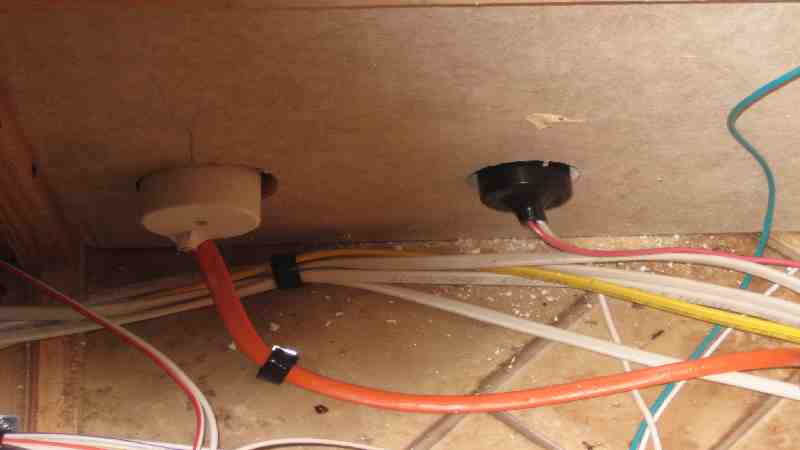
I also installed an outside shower - made the connections inside with Shark-bite connectors, cut out the wall with a jig saw and caulked the box /wall joint - a breeze. For privacy, I made a curtain rod holder- two adjustable flag pole holders, some 1/2" PVC pipe and a couple of elbows was all it took. When not used for a shower curtain, one of the holders has a US flag in it.
The other apparatus was used by the original owner to hold his larger saltwater rods and spinning reels - a clever rig, but I'm mostly a fly and ultra light guy so they get used for more mundane things like keeping the power cord off the ground.
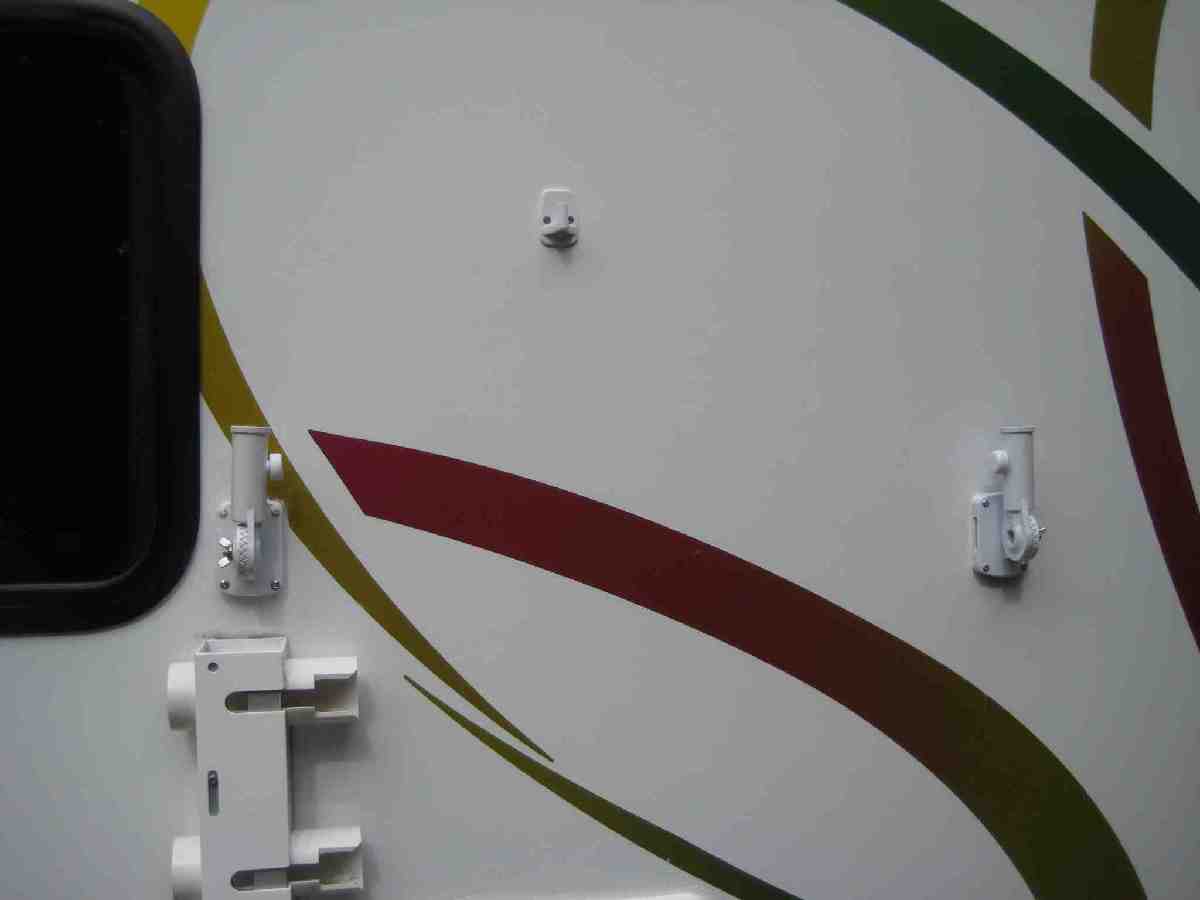
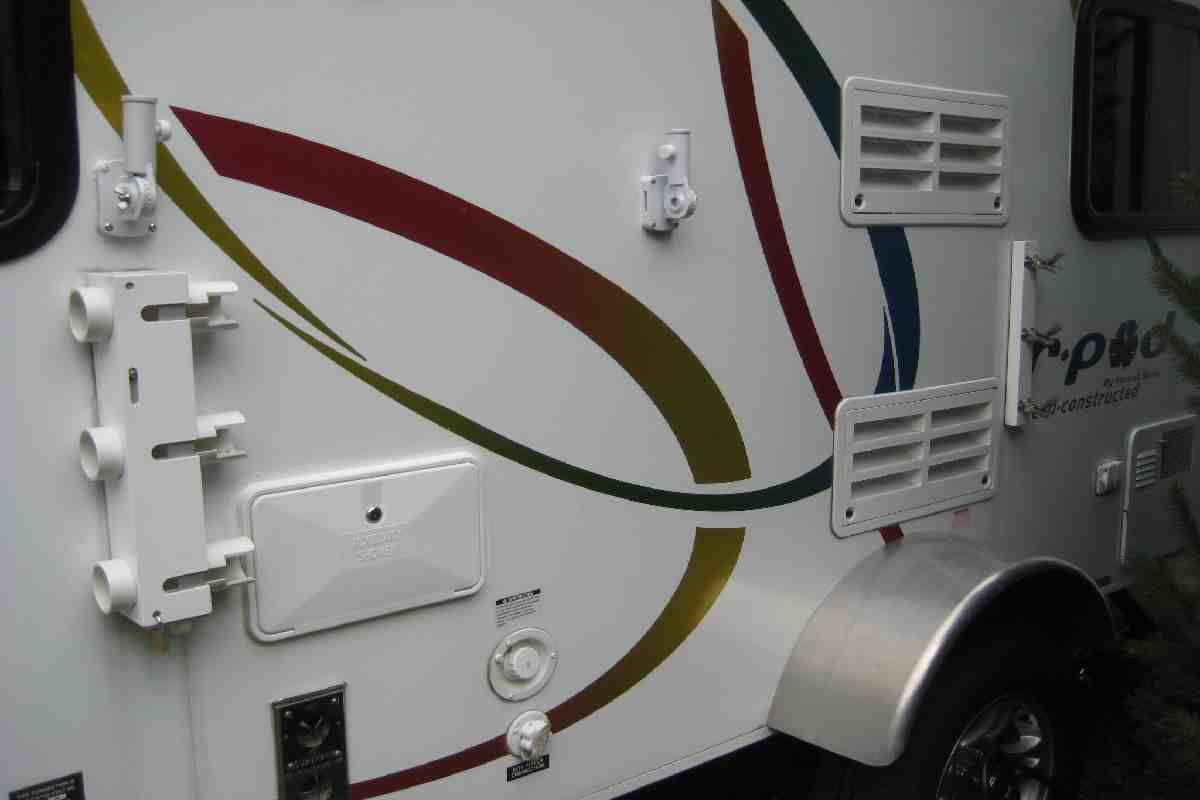
Walt
|
|
Chris and Walt
'10 RP-171 'Free Spirit'
'13 Dodge Durango Crew 5.7 L Hemi V8
|
 |
Footslogger03 
Senior Member


Joined: 21 Jul 2011
Location: Laramie, WY
Online Status: Offline
Posts: 362
|
 Posted: 20 Aug 2012 at 9:09pm Posted: 20 Aug 2012 at 9:09pm |
|
What kind of current are you generating in full sunlight ? Reason for asking is that I tried a 45 Watt (3 panel) system a few years ago and gave it up because I couldn't generate enough reliable current to make it worth the effort. I'm sure panel technology has improved since then.
'Slogger
|
|
Livin' the Dream ...'Slogger
|
 |
Keith-N-Dar 
podders Helping podders - pHp


Joined: 03 Apr 2011
Location: Mayville, WI
Online Status: Offline
Posts: 1447
|
 Posted: 20 Aug 2012 at 9:50pm Posted: 20 Aug 2012 at 9:50pm |
|
Apply Ohm's law. Current =Watts/Volts. Current = 30/12 or 2.5 amps. In reality my guess is that the voltage is a little higher on a sunny day so current will be a little lower. I am struggling with that low a power supply charging a deep cycle battery. Let us know how it works out.
|
|
Keith-N-Dar
Boris & Betty (Boston Terriers)
2011 R-Pod 177
2010 Ford F-150
|
 |
Podsible Dream 
podders Helping podders - pHp


Joined: 03 Dec 2010
Location: Hightstown, NJ
Online Status: Offline
Posts: 571
|
 Posted: 21 Aug 2012 at 10:11am Posted: 21 Aug 2012 at 10:11am |
|
Thanks for the input. The panel has a max of 2.65 A output. I am hoping that using our LED lights and the water pump only, we can keep the batteries charged. We run the fan, which seems to pull about 25 watts. If the panel isn't sufficient, then I get another one and connect them in series, or back it up with running the Truck, which is what I want to avoid. Or we could up grade to one of those flexible 100+ watt panels that are available.
In any event, it was a fun mod and tested my skills on a number of fronts.
I have to find a better photo editor, though, so I can compress the files and not lose resolution!
|
|
Chris and Walt
'10 RP-171 'Free Spirit'
'13 Dodge Durango Crew 5.7 L Hemi V8
|
 |
Seanl 
Senior Member


Joined: 19 Sep 2011
Location: Fredericton NB
Online Status: Offline
Posts: 633
|
 Posted: 21 Aug 2012 at 10:24am Posted: 21 Aug 2012 at 10:24am |
Originally posted by Keith-N-Dar
Apply Ohm's law. Current =Watts/Volts. Current = 30/12 or 2.5 amps. In reality my guess is that the voltage is a little higher on a sunny day so current will be a little lower. I am struggling with that low a power supply charging a deep cycle battery. Let us know how it works out. |
I have a 2.5 amp charger that I use for a maintenance charger. I once charged my battery with it when it was down and it took 5 days. So I can see the solar charger being used to maintain a charge on the battery I cannot see it charging it.
|
Sean, 2011 Rpod RP-173,2009 Jeep Liberty Rocky Mountain Edition

|
 |
techntrek 
Admin Group - pHp


Joined: 29 Jul 2009
Location: MD
Online Status: Offline
Posts: 9059
|
 Posted: 21 Aug 2012 at 12:17pm Posted: 21 Aug 2012 at 12:17pm |
All excellent upgrades. You'll run into the same thing I did with my outside shower mod - since the cover is right above the furnace exhaust, you might look into adding a small chain which will prevent the cover from extending beyond 90 degrees (parallel to the ground). If it falls in front of the exhaust it could melt or catch on fire. I haven't done this to mine yet, I only think about it in-camp.
Something to consider with small solar systems - and this probably explains Footslogger's frustration with his - is lead-acid batteries will loose about an amp per day just in self-discharge. The solar system must overcome that loss PLUS anything you actually use each day. On top of that, you can expect to only get about 80% of the solar panel's rating - on a good day. Those ratings indicate best-case scenarios, like very cold temperatures with snow reflecting the sun. Add to that you can expect to loose up to 50% of the actual generated output in line losses, charger inefficiency, battery inefficiency, inverter inefficiency, etc. That number might be closer to 40% loss if you are using 12 volts directly and not using an inverter. Finally, most areas of the US get about 4 "solar insolation" hours per day on average over a year. That number will be slightly higher over the summer when RV systems will be in use, say 4.5 hours. Many people think "hey, its light outside 14 hours over the summer" so they think they'll get far more total amps from the system than they really will. You have to account for the low angle of the sun, clouds, rain, etc.
So, a 45 watt system = 3.75 amp-hour * .80 = 3 amp-hour (on a good day)
Subtract 40%, 3 amp-hour * .60 = 1.8 amp-hour
4.5 hours * 1.8 amp-hour = 8.1 amps per day
Subtract self-discharge = 8.1 - 1 = 7.1 amps per day
As long as you use less than 7.1 amps per day AND you get full sun every day, then you will charge your battery - some, not much. You will use more than 7 amps per day even with just the LP detector (2.3 amps per day on one model I just looked up) and the "brains" of the fridge on LPG mode (6 amps per day). Add an hour or three of lights and water pump use and you will be way above 7 amps per day.
|
|
|
 |
Podsible Dream 
podders Helping podders - pHp


Joined: 03 Dec 2010
Location: Hightstown, NJ
Online Status: Offline
Posts: 571
|
 Posted: 21 Aug 2012 at 1:32pm Posted: 21 Aug 2012 at 1:32pm |
|
Thanks for the lesson, Doug.
I'll monitor the system and se what I need to do next. I did get a watt meter from RCA-electronics that I will install next. It was part of this operation, but I haven't done it yet. As it goes between the battery and the load, and I want it inside, I have to do some planning for the wiring install.
The lid indeed flops all the way down. I've got some bead chain in the basement somewhere to make a cover retainer. It will then double as a holder for cleaning supplies!
BTW the lock and key set on my shower box is the same number as the locks on the rear pass thrus....
|
|
Chris and Walt
'10 RP-171 'Free Spirit'
'13 Dodge Durango Crew 5.7 L Hemi V8
|
 |
bhamster 
Senior Member

Joined: 19 May 2011
Location: Washington
Online Status: Offline
Posts: 165
|
 Posted: 21 Aug 2012 at 2:33pm Posted: 21 Aug 2012 at 2:33pm |
techntrek: These are important considerations, but I disagree with the numbers:
First of all (sorry to be nitpicky  ), an amp is a measure of current which is the flow of electric charge. It's an instantaneous measurement and doesn't make sense to use over time ("amps per day" doesn't mean anything). If you want to describe an amount of electric charge then use amp hour (Ah).
On to the numbers themselves:
Maybe you only get 4 hours of ideal sun, but there is still a full day of light that is generating a useful amount of electricity (even on a cloudy day). I would argue that the total amount of light hitting the panel during the entire day is equivalent to about 8 hours of full sunlight. You will need to re-position your panel occasionally to achieve this though.
As for efficiency, I lose about 12% from a hot panel (check STC vs PTC) and 8 percent from the charger, so I get 80% of the panel rating out of the charger.
After the charger our numbers will be different because I'm using an AGM battery (which I would highly recommend for solar use). Self-discharge is almost 0, and internal resistance is around 2%. Charging efficiency for an AGM is around 90% at room temperature. Also, if you're losing energy to line losses, you just need thicker cables.
So, the overall calculation is:
3.75A * 0.8 (panel and charger loss) * 0.9 (AGM loss) * 8 hours = 21.6 Ah
21.6Ah - 7Ah (LP detector) - 6Ah (fridge) - 0.09Ah (self-discharge) = 8.51Ah net charge.
That might not seem like much, but that's equivalent to (separately, not cumulatively):
water pump: 2 hours furnace: 3 hours
led light: 40 hours
That's way more than I need to use in a day, so my solar charger is able to bring me back up to 100% every day. In fact, once it goes into maintenance mode (desulfation) then I plug in my phone charger and a couple duracell usb batteries to try and capture some of the surplus energy.
|
 |
techntrek 
Admin Group - pHp


Joined: 29 Jul 2009
Location: MD
Online Status: Offline
Posts: 9059
|
 Posted: 21 Aug 2012 at 5:38pm Posted: 21 Aug 2012 at 5:38pm |
I only have a minute here before I run out the door (to go home), but I understand your nitpickyness about amps vs. amp-hour. Just trying to be clearer to average Joe. :-)
As for your system efficiency, that adds up to 72% system efficiency not including line losses (which always exists even with properly sized wiring), not too far from my 60% which includes a small fudge factor to account for things like increased losses in the battery as it ages.
Take a look and you'll see that my 4.5 number is correct. It is slightly higher in the southwest and slightly lower near the Canadian border, but in general it is right. That number takes into account many, many factors to give you a true yearly average.
|
|
|
 |
Camper Bob 
podders Helping podders - pHp

Joined: 26 Sep 2011
Location: Portland Oregon
Online Status: Offline
Posts: 913
|
 Posted: 21 Aug 2012 at 6:00pm Posted: 21 Aug 2012 at 6:00pm |
|
Wow. Did anyone else really understand that. I'm sure your both right, but to us mere mortals, that was mind dazzling. Glad we have some technowizards on board. Safe Travels.
|
|
Camper Bob and Camper Sue
Gracie the Wonder Dog (12 LB. Mini Dachshund)
2013 Rpod 171HRE(ORPod)
2016 Lance 1685
2015 Nissan Pathfinder
|
 |




